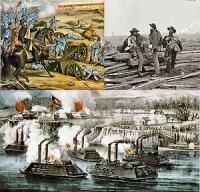Home | Military Conflict | American Civil War
|
|
|
The American Civil War (1861 � 1865) was a civil war in the United States of America. Eleven Southern slave states declared their secession from the United States and formed the Confederate States of America ("the Confederacy") to fight for independence. Twenty (mostly Northern) free states in which slavery already had been abolished, and five slave states that became known as the "border states" supported the federal government. These twenty-five states, referred to as the Union, had a much larger base of population and industry than the South. After four years of warfare, mostly within the Southern states, the Confederacy surrendered and slavery was outlawed everywhere in the nation. Issues that led to war were resolved only in the Reconstruction Era that followed the restoration of the Union. In the presidential election of 1860, the Republican Party, led by Abraham Lincoln, had campaigned against the expansion of slavery beyond the states in which it already existed. The Republicans were strong advocates of nationalism and in their 1860 platform explicitly denounced threats of disunion as avowals of treason. After a Republican victory, but before the new administration took office on March 4, 1861, seven cotton states declared their secession and joined together to form the Confederate States of America. Both the outgoing administration of President James Buchanan and the incoming administration rejected the legality of secession, considering it rebellion. The other eight slave states rejected calls for secession at this point. No country in the world recognized the Confederacy. Hostilities began on April 12, 1861, when Confederate forces attacked a U.S. military installation at Fort Sumter in South Carolina. Lincoln responded by calling for a volunteer army from each state to recapture federal property. This led to declarations of secession by four more slave states. Both sides raised armies as the Union seized control of the border states early in the war and established a naval blockade that virtually ended cotton sales on which the South depended for its wealth, and blocked most imports. Land warfare in the East was inconclusive in 1861 � 62, as the Confederacy beat back Union efforts to capture its capital, Richmond, Virginia. In September 1862, Lincoln's Emancipation Proclamation made ending slavery in the South a war goal, and dissuaded the British from intervening. Confederate commander Robert E. Lee won battles in Virginia, but in 1863 his northward advance was turned back with heavy casualties after the Battle of Gettysburg. To the west, the Union gained control of the Mississippi River after their capture of Vicksburg, Mississippi, thereby splitting the Confederacy in two. The Union was able to capitalize on its long-term advantages in men and materiel by 1864 when Ulysses S. Grant fought battles of attrition against Lee, while Union general William Tecumseh Sherman captured Atlanta and marched to the sea. Confederate resistance ended after Lee surrendered to Grant at Appomattox Court House on April 9, 1865. The American Civil War was one of the earliest true industrial wars. Railroads, the telegraph, steamships, and mass-produced weapons were employed extensively. The practices of total war, developed by Sherman in Georgia, and of trench warfare around Petersburg foreshadowed World War I in Europe. It remains the deadliest war in American history, resulting in the deaths of 620,000 soldiers and an undetermined number of civilian casualties. According to John Huddleston, "Ten percent of all Northern males 20 � 45 years of age died, as did 30 percent of all Southern white males aged 18 � 40." Victory for the North meant the end of the Confederacy and of slavery in the United States, and strengthened the role of the federal government. The social, political, economic and racial issues of the war decisively shaped the reconstruction era that lasted to 1877. |




 RSS
RSS